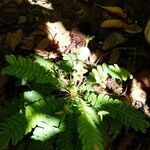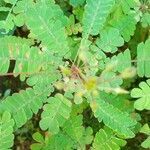Annuals 5-25 cm tall, base woody. Stem simple, slender to robust, hispid especially apically. Leaves 3-13 cm; rachis slender, moderately hispid; leaflets 6-14 pairs; leaflet blades oblong to obovate-oblong, 3-15 × 2-7 mm, usually glabrous, occasionally sparsely covered with trichomes, base almost symmetric. Umbels several flowered; peduncle 2-7 cm, subequal to leaf length; bracts several, lanceolate, ca. 2 mm, densely crowded at apex of peduncle, cluster ca. 3 mm. Pedicel ca. 1 mm at anthesis but to 3 mm in fruit. Sepals 5-6 mm, with glandular septate trichomes. Petals yellow, longer than sepals. Capsule ellipsoid-obovoid, 4-5 × 3-4 mm, pubescent. Fl. and fr. Jul-Dec.
Leaves 3–13 cm. long; leaflets up to 21-jugate, 3–8 × 2·5–5 mm., subsessile, opaque, usually square to oblong, slightly oblique, appressed-pilose or-pubescent, apex rounded, base truncate, with rather inconspicuous lateral nerves making an acute angle with the midrib; rhachis pilose.
Flowers white, pink, lilac or yellow, with pubescent pedicels up to 6 mm. long, in 3–10-flowered pseudumbels; peduncle up to 13 cm. long, pubescent, Sepals 4–5 × 1–1·5 mm., narrowly lanceolate, acuminate, acute, 3–5-nerved, pubescent.
An annual herb. It grows 10-40 cm high. The leaves are 3-13 cm long. There are 21 leaflets. They are 3-8 mm long by 3-5 mm wide. The flowers are white, yellow or pink.
Annual herb 10–40 cm. in height with a simple slender to rather stout stem with a single rosette of leaves at the apex.
Ovary deeply 5-lobed; styles 1–3 mm. long (said to be trimorphic), pubescent.
Seeds 0·5 × 0·3 mm., flattened-ellipsoid, minutely tuberculate, brown.
Stamens with 5 longer ones 3 mm. long and 5 shorter ones 1·5 mm. long.
Petals 7–8 mm. long, spathulate, glabrous.
Capsule 3 × 2 mm., obovate-ellipsoid.





